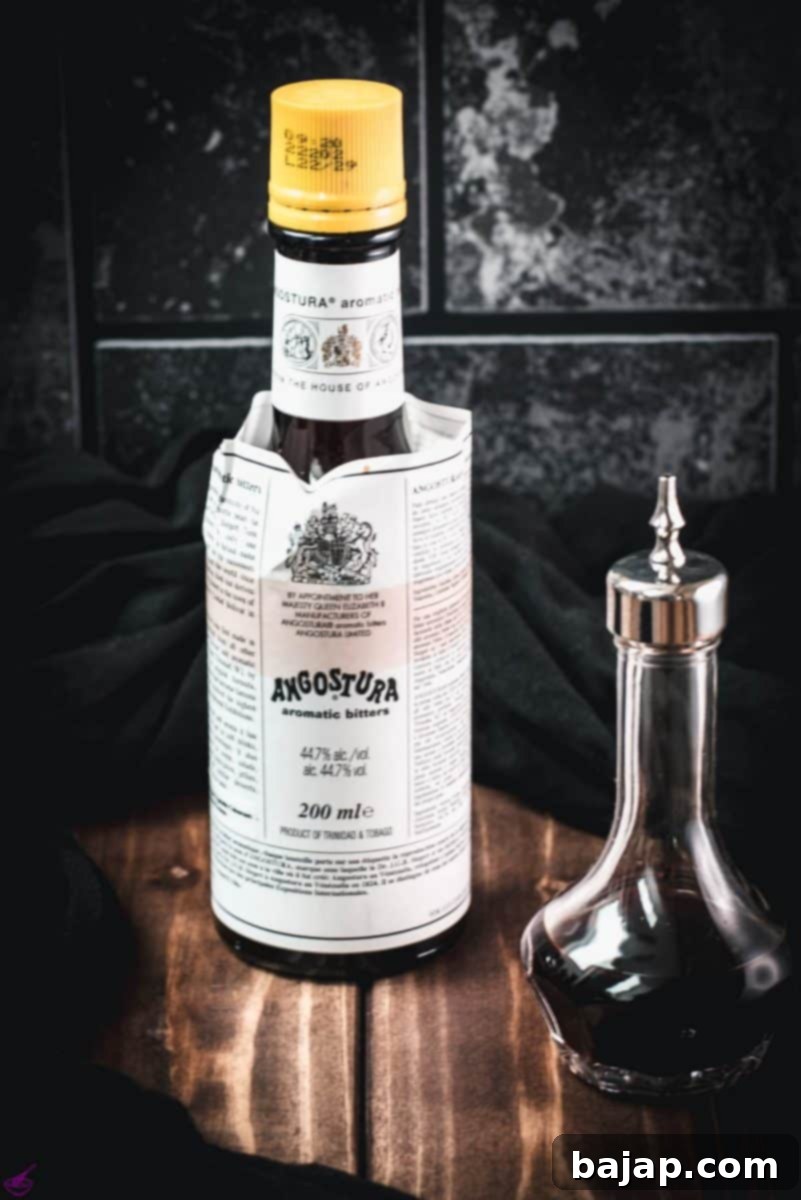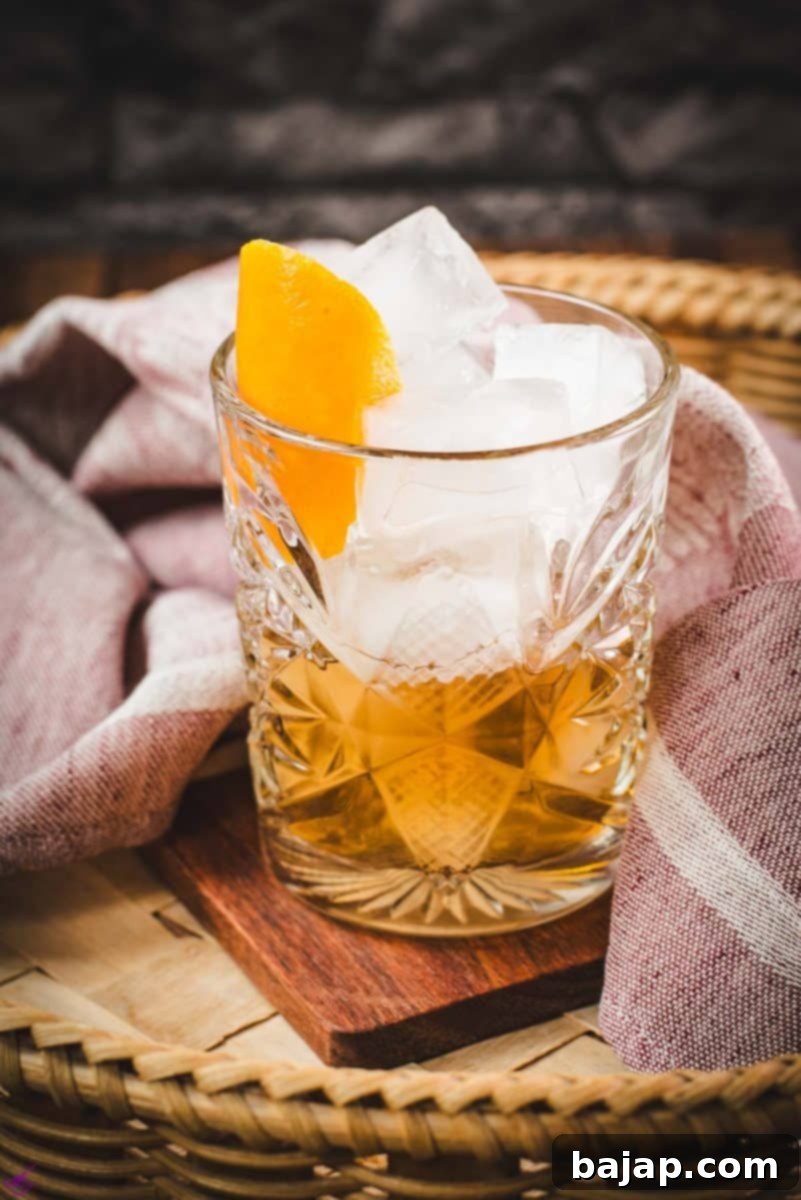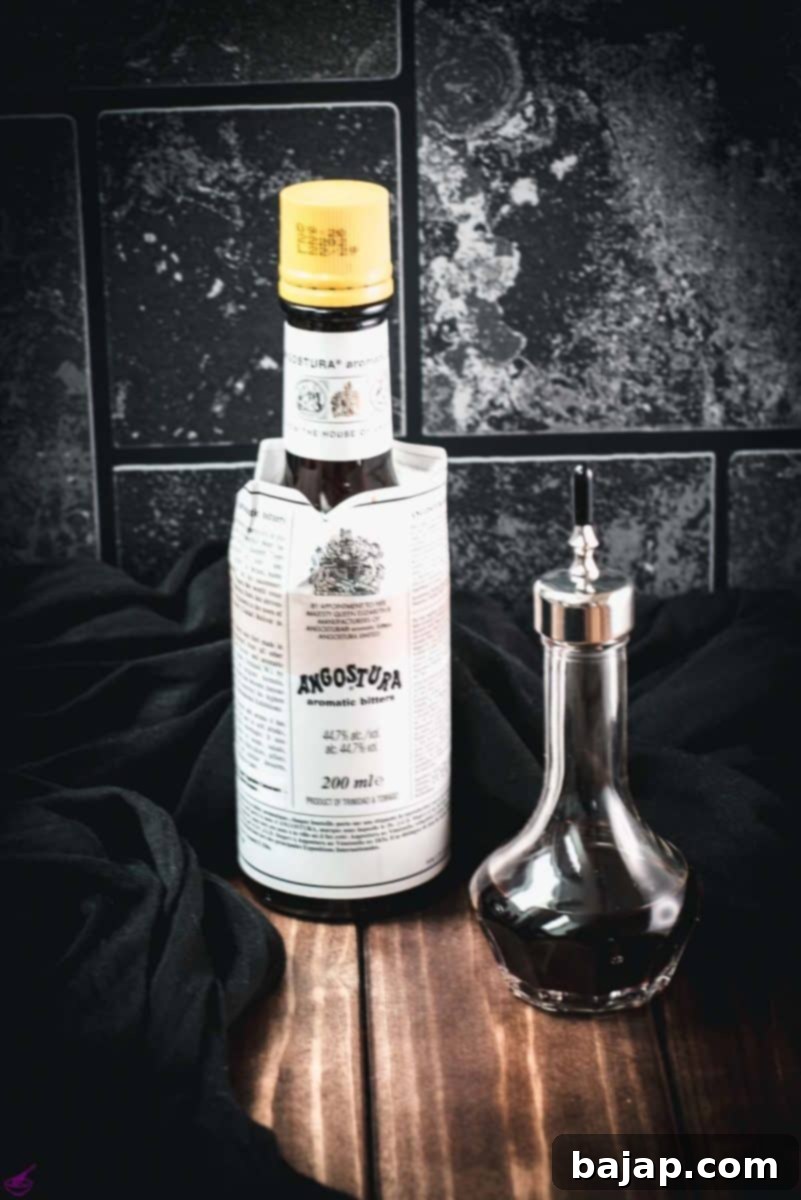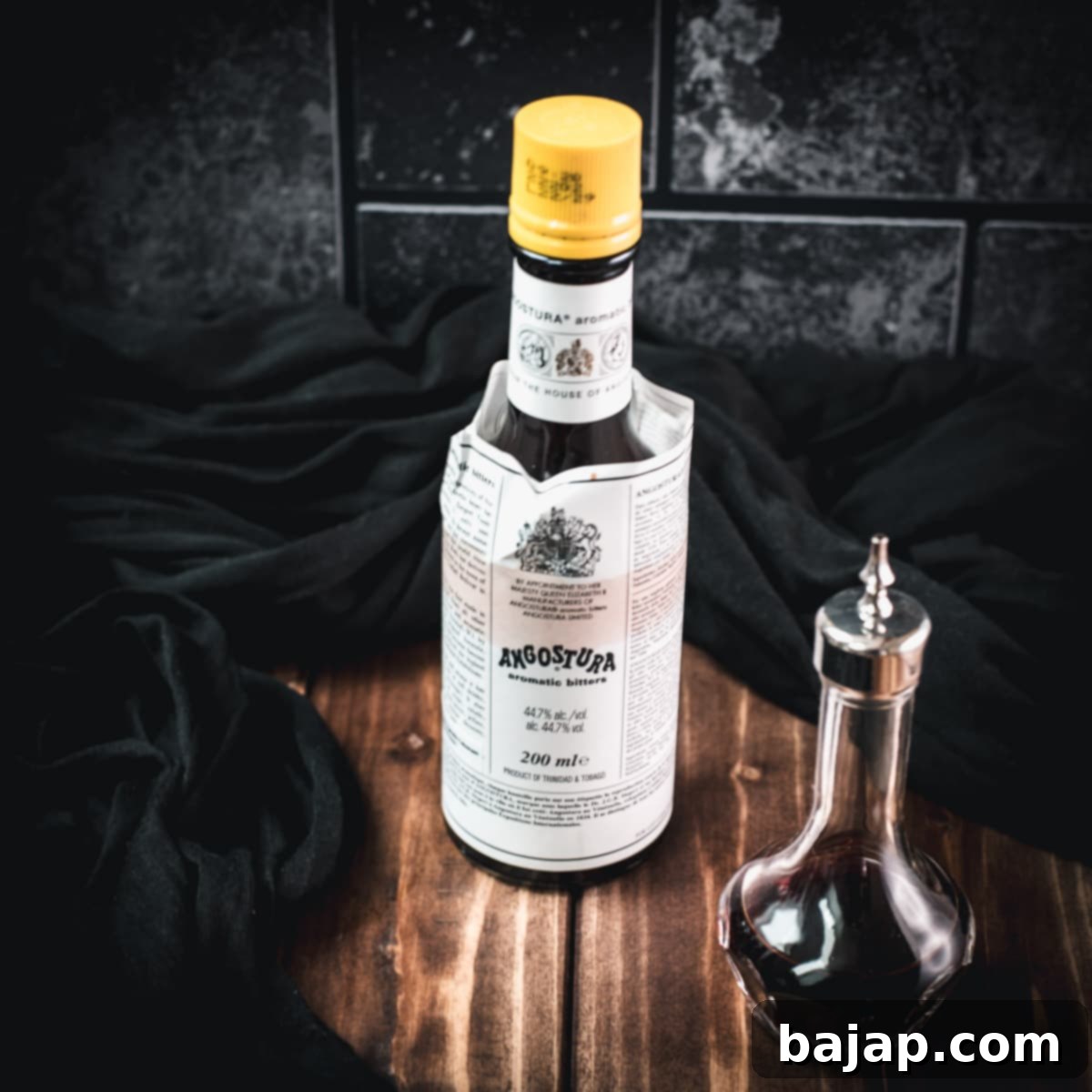Angostura Bitters: The Essential Ingredient for Elevating Your Cocktails and Home Bar
Every well-stocked home bar has its foundational spirits and mixers, but the true magic often lies in the details—the secret ingredients that transform a good drink into an extraordinary one. Among these unsung heroes, Angostura Bitters stands out as an indispensable bar-aid, a small bottle with a colossal impact. But what exactly is this aromatic elixir, and how do you unlock its full potential to craft show-stopping cocktails? Join us as we pour out all the essential details about Angostura Bitters, from its fascinating origins to its myriad uses, ensuring your next drink is nothing short of perfection.

What Are Angostura Bitters?
Angostura Bitters is a highly concentrated, aromatic flavoring used extensively in cocktails and, surprisingly, even in culinary applications. Its complex flavor profile is a delightful symphony of warm, exotic spices—think cloves, cinnamon, nutmeg, and cardamom—layered with subtle notes of bitter orange peel and a light, fruity undertone. This intricate blend creates an exciting and robust taste that pairs exquisitely with a wide array of classic spirits, including rich bourbon, smooth brandy, spiced rum, and crisp gin, making it a cornerstone of cocktail mixology.
Originating in the town of Angostura, Venezuela (now Ciudad Bolívar), this distinctive mixture was first created in 1824 by Dr. Johann Gottlieb Benjamin Siegert, a German surgeon general in Simón Bolívar’s army. His initial intention was to formulate a medicinal tonic to alleviate digestive ailments among soldiers. However, its potent aromatic qualities and unique taste quickly garnered attention beyond the infirmary, finding its way into local taverns and eventually onto the global stage. Today, Angostura Bitters are exclusively produced in Trinidad and Tobago, where the closely guarded, secret recipe continues to be meticulously followed.
The base of Angostura Bitters consists of a proprietary blend of aromatic botanicals. While the exact recipe remains a trade secret, key ingredients are known to include gentian root, cinchona bark, and a diverse array of spices. These botanicals are steeped in a high-proof alcohol base, creating a tincture that boasts a pronounced flavor of earthy, warm, and deeply complex spice. This strong, spicy, and slightly bitter flavor makes it a bracing, yet balancing, addition to any cocktail, cutting through sweetness and adding depth that no other ingredient can quite replicate. It’s truly a testament to its enduring appeal that a concoction originally designed as medicine has become an indispensable flavoring agent for the world’s finest drinks.
The Fascinating History Behind the Bottle
The story of Angostura Bitters is as rich and intriguing as its flavor. Dr. Siegert spent years perfecting his formula, experimenting with various herbs and botanicals native to the region. His creation was initially known as “Amargo Aromatico” (Aromatic Bitters) and was highly valued for its perceived medicinal properties, particularly for stomach ailments. As word spread, sailors and traders visiting Angostura began taking bottles with them, introducing the bitters to international ports and, eventually, to the burgeoning cocktail scene of the 19th century.
A curious detail about Angostura Bitters is its distinctive oversized label, which often appears too large for the bottle itself. Legend has it that the Siegert brothers, who took over the business, had a disagreement: one designed the bottle, the other the label, and neither consulted the other on size. By the time they realized the mismatch, the product was already famous, and they decided to keep the quirky label as a unique identifier. This charming tale only adds to the mystique of this iconic brand, making it instantly recognizable on any bar shelf.
From its humble beginnings as a medicinal tonic to its current status as a global cocktail essential, Angostura Bitters has evolved, but its commitment to quality and its secret recipe has remained steadfast. It’s a product that bridges centuries, connecting modern mixologists to the traditions of the past.
The Classic Old Fashioned: A Star Performance

When most people conjure an image of Angostura Bitters in action, one drink immediately comes to mind: the venerable Old Fashioned. This sensational bourbon cocktail is not just a drink; it’s an institution, and its enduring popularity is due in no small part to the complex, balancing flavor contributed by Angostura Bitters.
In this amazing drink, a few dashes of Angostura Bitters meld with sugar and a splash of water, creating a spicy, subtly sweet, and aromatic base for the luscious, smooth bourbon. The bitters cut through the sweetness of the sugar, preventing the drink from becoming cloying, and simultaneously amplify the inherent notes of the whiskey. You’ll discover lovely woodiness, a captivating array of spices, and bright orange notes that awaken and excite every cocktail lover’s palate. The bitters act as a bridge, harmonizing the robust spirit with the sweetness, creating a perfectly rounded and incredibly satisfying experience.
Crafting an Old Fashioned is a ritual, a testament to simplicity and quality ingredients. If you’re eager to master this quintessential cocktail, check out my deliciously simple, classic Old Fashioned recipe to learn how to make this crowd-pleasing drink with ease. It’s the perfect starting point to appreciate the profound impact a few drops of Angostura can have.
Beyond the Old Fashioned: Versatile Uses of Angostura Bitters
While the Old Fashioned undoubtedly holds a star position, it’s far from the only stage where Angostura Bitters shines! So many delightful drinks and even culinary creations benefit from the sizzling, complex flavor of these bitters. Angostura’s ability to add depth, balance, and a unique aromatic quality makes it incredibly versatile, pushing it beyond just whiskey-based drinks.
If you’re ready to venture beyond the ‘Old Fashioned,’ prepare to explore a world of incredible classics and innovative concoctions that can be elevated with Angostura Bitters:
- Manhattan: An absolute classic where Angostura beautifully complements rye whiskey and sweet vermouth.
- Sazerac: A New Orleans gem, often calling for a dash of Peychaud’s, but Angostura can be used alongside or as an alternative for a deeper spice profile.
- Negroni: While traditionally not using bitters, a dash can add an intriguing layer to its bitter-sweet balance.
- Pink Gin: A simple yet elegant concoction where Angostura gives gin a subtle rosy hue and a delightful aromatic kick.
- Mai Tai: A tropical classic where a dash or two can enhance the rum and citrus notes, adding a layer of complexity.
- Champagne Cocktail: A sugar cube, a few dashes of Angostura, and sparkling wine—simple elegance redefined.
- Pisco Sour: Often garnished with a few drops on top, adding a beautiful aroma and visual appeal.
- Trinidad Sour: A cocktail that uniquely features Angostura Bitters as its primary base spirit, showcasing its incredible depth.
- Rum Swizzles & Tropical Drinks: Bitters can prevent overly sweet tropical drinks from becoming cloying, adding a sophisticated edge.
- Non-Alcoholic Beverages: A dash in sparkling water, lemonade, or ginger ale can create a surprisingly sophisticated mocktail, adding flavor without alcohol.
But the versatility of Angostura Bitters isn’t limited to the bar. Its unique blend of spices makes it a fantastic culinary ingredient. Try adding a dash to marinades for meats, especially pork or chicken, to deepen their flavor. It can also enhance savory sauces, soups, and even desserts like fruit salads, chocolate mousse, or whipped cream. Think of it as a liquid spice rack, ready to impart warmth and complexity with just a few drops.

Where to Buy Angostura Bitters and Usage Tips
Fortunately for budding bartenders and seasoned mixologists alike, Angostura Bitters are remarkably easy to find. Its widespread popularity ensures it’s stocked by a multitude of retailers, both online and in brick-and-mortar stores, making it accessible to virtually anyone looking to elevate their drink game.
You’ll typically find Angostura Bitters in the liquor department of most major national grocery stores, such as Albertsons, Kroger, or Whole Foods, usually situated near the cocktail mixers, vermouths, or other bar essentials. Dedicated liquor stores nationwide, from small, independent shops to large chains like Binny’s or Total Wine & More, almost invariably carry these bitters. If convenience is key, you can simply sit back and let the bitters come to you by ordering them online from major e-commerce platforms like Amazon or specialized online liquor retailers.
Bitters bottles come in various sizes, with the 4-ounce and 16-ounce sizes being the most popular for home use. Given that bitters are typically portioned in small dashes (just a few drops at a time), a single bottle, even a smaller one, can last for a considerable period. Due to their high alcohol content, bitters don’t truly “spoil” in the traditional sense, but they can gradually lose their potency and vibrant aroma over many years. Therefore, while checking an explicit expiration date might not always be critical, it’s a good practice to note the purchase date and consider replacing a very old bottle if you notice a decline in its aromatic intensity. It also never hurts to check the quality and freshness of bottles in the store, especially if they appear dusty or have been sitting for a long time.
Tips for Using Angostura Bitters Effectively:
- Start Small: A little goes a long way. Most recipes call for “1-2 dashes.” A “dash” typically equates to about 3-5 drops. It’s always easier to add more than to take away.
- Balance is Key: Use bitters to balance sweetness, add complexity to simple spirits, or enhance existing flavors. They are a background player, not the star, aiming to round out the drink.
- Experiment Fearlessly: While essential for classics, don’t be afraid to experiment with Angostura in new or unexpected combinations. Try a dash in a Gin & Tonic, a Margarita, or even a non-alcoholic soda water with a squeeze of citrus.
- Culinary Adventures: Remember its versatility beyond cocktails. A few drops can elevate soups, stews, sauces, and desserts, particularly those with chocolate or fruit.
- Storage: Store your bottle of Angostura Bitters in a cool, dark place, away from direct sunlight, to preserve its aromatic integrity for as long as possible.
Looking to stock up? Check out Angostura Aromatic Cocktail Bitters on Amazon.
One Last Dash: Unleash Your Inner Mixologist!
Angostura Bitters is more than just an ingredient; it’s a catalyst that elevates average cocktails into extraordinary experiences. With its smooth, spicy, and deeply aromatic flavor, this essential bar-aid empowers you to easily mix up beloved cocktail classics and to fearlessly invent new concoctions. The true magic, however, lies in your hands—your willingness to explore, taste, and adjust.
So, have fun mixing up delicious drinks, and don’t be afraid to experiment with the incredible depth and versatility that Angostura Bitters brings to the table. Whether you’re crafting a timeless Old Fashioned or a daring new creation, a dash or two of Angostura is often the secret ingredient that makes all the difference, transforming your home bar into a realm of endless flavor possibilities!
You Might Also Like
- Bourbon Old Fashioned
- Strawberry Moscow Mule
- Gin and Tonic with Lemon
- How To Make Aperol Spritz
Food Safety Considerations
While Angostura Bitters itself is a shelf-stable ingredient, responsible food and drink preparation always includes adherence to safety guidelines. These general food safety tips are important for any home cook or bartender:
- Cook to a minimum temperature of 165 °F (74 °C) for meats and poultry to ensure harmful bacteria are eliminated.
- Avoid cross-contamination by not using the same utensils or cutting boards on cooked food that previously touched raw meat.
- Always wash hands thoroughly with soap and water after handling raw meat, poultry, or seafood.
- Do not leave perishable food sitting out at room temperature for extended periods; refrigerate promptly.
- Never leave cooking food unattended on the stove or in the oven to prevent accidents.
- When frying or sautéing, use oils with a high smoking point to avoid the production of harmful compounds.
- Always ensure good ventilation in your kitchen, especially when using a gas stove, to maintain air quality.
For further comprehensive information on safe food handling, please check Safe Food Handling – FDA.
